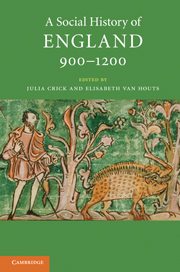Book contents
- Frontmatter
- Contents
- List of figures
- List of maps and tables
- List of contributors
- Acknowledgements
- List of abbreviations
- Map 1 England and its neighbours
- Map 2 England 900–1200
- I Introduction
- I.1 Land use and people
- I.2 Water and land
- I.3 Forest and upland
- I.4 Mineral resources
- I.5 Health and disease
- II.1 Authority and community
- II.2 Lordship and labour
- II.3 Order and justice
- II.4 War and violence
- II.5 Family, marriage, kinship
- II.6 Poor and powerless
- III.1 Towns and their hinterlands
- III.2 Commerce and markets
- III.3 Urban planning
- III.4 Urban populations and associations
- IV.1 Invasion and migration
- IV.2 Ethnicity and acculturation
- IV.3 Intermarriage
- IV.4 The Jews
- V.1 Religion and belief
- V.2 Rites of passage and pastoral care
- V.3 Saints and cults
- V.4 Public spectacle
- V.5 Textual communities (Latin)
- V.6 Textual communities (vernacular)
- VI.1 Learning and training
- VI.2 Information and its retrieval
- VI.3 Esoteric knowledge
- VI.4 Medical practice and theory
- VI.5 Subversion
- Glossary
- Time line 900–1200
- Further reading
- Index
- References
V.2 - Rites of passage and pastoral care
Published online by Cambridge University Press: 05 June 2012
- Frontmatter
- Contents
- List of figures
- List of maps and tables
- List of contributors
- Acknowledgements
- List of abbreviations
- Map 1 England and its neighbours
- Map 2 England 900–1200
- I Introduction
- I.1 Land use and people
- I.2 Water and land
- I.3 Forest and upland
- I.4 Mineral resources
- I.5 Health and disease
- II.1 Authority and community
- II.2 Lordship and labour
- II.3 Order and justice
- II.4 War and violence
- II.5 Family, marriage, kinship
- II.6 Poor and powerless
- III.1 Towns and their hinterlands
- III.2 Commerce and markets
- III.3 Urban planning
- III.4 Urban populations and associations
- IV.1 Invasion and migration
- IV.2 Ethnicity and acculturation
- IV.3 Intermarriage
- IV.4 The Jews
- V.1 Religion and belief
- V.2 Rites of passage and pastoral care
- V.3 Saints and cults
- V.4 Public spectacle
- V.5 Textual communities (Latin)
- V.6 Textual communities (vernacular)
- VI.1 Learning and training
- VI.2 Information and its retrieval
- VI.3 Esoteric knowledge
- VI.4 Medical practice and theory
- VI.5 Subversion
- Glossary
- Time line 900–1200
- Further reading
- Index
- References
Summary
It is probably true to say that medieval churchmen in the period 900–1200 displayed rather more interest in the delivery of pastoral care than modern historians have done until very recently. Dismissed as routine, pastoral care has been overlooked in favour of the dramatic transformations unfolding in monasticism, saints' cults and the crusades in the course of these three centuries. Yet the mundane business of the cure of souls lay at the heart of all Christians' experience of the Church to which they belonged. Giles Constable has defined pastoral care as ‘the performance of those ceremonies that were central to the salvation of the individual Christian and that were the primary responsibility of ordained priests working in [local] churches’: the Mass, baptism, penance, the last rites and burial of the dead, that is the fundamental rites of Christian life, the cura animarum. This chapter will focus mainly on the rites for entry into, and exit from, life and the earthly Christian community. The evidence for pastoral care ranges from the prescriptive laws, aspirational liturgical rites, model sermons and other texts to the physical remnants of buildings, ecclesiastical furnishings and interments. Whilst much of the textual evidence is the work of second-generation reformers in the late tenth century and the first decades of the eleventh century, led by Ælfric and Wulfstan I, archbishop of York and bishop of Worcester, there is sufficient testimony, especially when combined with the material evidence, to suggest pastoral care was important to both churchmen and laymen throughout this period.
- Type
- Chapter
- Information
- A Social History of England, 900–1200 , pp. 290 - 308Publisher: Cambridge University PressPrint publication year: 2011
References
- 1
- Cited by



